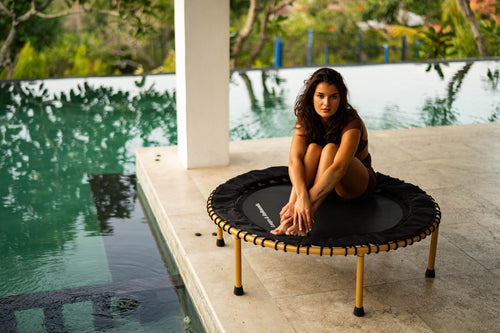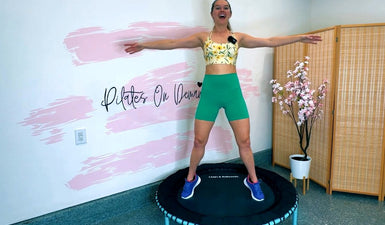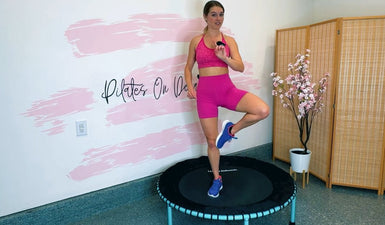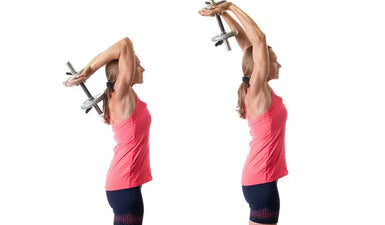So, you're looking to shake up your fitness routine and maybe have a little fun while you're at it? I get it. Sticking to the same old exercises can get boring, and sometimes you just need something different. That's where youtube rebounding exercise comes in. It's this cool way to get a good workout using a mini trampoline, and honestly, it's way more effective and enjoyable than you might think. We're going to dive into why it's so good for you and how you can easily start doing it right at home with videos you can find online.
Key Takeaways
- Youtube rebounding exercise offers a low-impact cardio workout that's gentle on your joints, making it suitable for many fitness levels.
- Jumping on a rebounder can help strengthen your bones, improve your mood by releasing endorphins, and support your body's lymphatic system.
- You can find a wide variety of youtube rebounding exercise videos, from beginner routines to high-intensity interval training and dance-focused sessions.
- To get the most out of your youtube rebounding exercise, choose a good rebounder, focus on proper form, and remember to stay hydrated.
- Watching reputable fitness channels on YouTube can help you find safe and effective youtube rebounding exercise content that fits your goals.
Understanding The Benefits Of YouTube Rebounding Exercise

So, you're thinking about jumping on a mini-trampoline for your next workout? Smart move. Rebounding, or bouncing on a rebounder, is way more than just a fun way to get your heart rate up. It's a seriously effective exercise that's surprisingly gentle on your body. Let's break down why it's such a good idea to incorporate these YouTube workouts into your routine.
Low-Impact Cardio For Joint Health
This is a big one. If you've ever felt the ache in your knees after a run or a high-impact aerobics class, you'll appreciate rebounding. The gentle up-and-down motion absorbs a lot of the shock that would normally go straight to your joints. Think of it like this: when you land on the rebounder, the mat and springs give way, cushioning your impact. This means you can get a really good cardiovascular workout, making your heart and lungs work harder, without all the pounding. It's a fantastic option if you're dealing with joint pain, recovering from an injury, or just want to be kinder to your body long-term.
Enhancing Bone Density And Strength
It might seem counterintuitive, but bouncing actually helps your bones. When you jump, your body experiences a slight G-force. This gentle stress signals your bones to get stronger. Studies have shown that regular rebounding can help decrease bone breakdown and actually encourage new bone formation. Over time, this can lead to better bone density and reduced risk of conditions like osteoporosis. It's like giving your skeleton a little workout, making it more resilient.
Supporting Lymphatic System Function
Your lymphatic system is a pretty important part of your immune system, but it doesn't have its own pump like your heart does. It relies on movement to circulate. Rebounding is brilliant for this. The rhythmic bouncing action helps to move lymph fluid throughout your body. This fluid carries waste products and toxins away from your cells. So, by rebounding, you're essentially helping your body to naturally detoxify and keep your immune system running smoothly. Pretty neat, right?
Boosting Mood And Releasing Endorphins
Let's be honest, sometimes getting motivated to exercise is the hardest part. But rebounding is genuinely fun! The simple act of bouncing can be incredibly uplifting. Plus, like most forms of exercise, it triggers the release of endorphins – those feel-good chemicals in your brain. This can help reduce stress, improve your mood, and leave you feeling more energized and positive after a session. It's a great way to shake off the day's worries and get a dose of happy.
Rebounding offers a unique combination of benefits, from being easy on your joints to actively improving your bone health and supporting your body's natural detoxification processes. It's a workout that truly works your whole system, inside and out, and it does it all with a smile.
Exploring Different YouTube Rebounding Workouts

So, you've got your rebounder, and you're ready to bounce. Awesome! But what exactly do you do on this thing? Luckily, YouTube is packed with all sorts of rebounding routines, so you're not stuck just jumping up and down endlessly (though that's fine too!). There's a whole world of bouncing styles out there, catering to pretty much everyone.
Beginner-Friendly Rebounding Routines
If you're just starting out, the key is to keep it simple and focus on getting the hang of the basic bounce. These workouts usually start with a gentle "health bounce" – just a light up-and-down motion. They'll often guide you through simple movements like jogging in place, gentle twists, or even just sitting and bouncing. The goal here is to build confidence and get your body used to the motion without overdoing it. You'll find routines that are 10-20 minutes long, perfect for easing into it. They often emphasize proper posture and controlled movements, which is super important when you're new.
High-Intensity Interval Training (HIIT) On The Rebounder
Ready to kick things up a notch? HIIT workouts on a rebounder are no joke. These sessions involve short bursts of really intense bouncing, followed by brief recovery periods. Think fast-paced jumping jacks, high knees, or quick sprints on the spot, all done with maximum effort for about 30 seconds, then a quick 15-30 second rest. This cycle repeats for the duration of the workout, usually around 20-30 minutes. It's a fantastic way to torch calories and boost your cardiovascular fitness in a short amount of time. You'll definitely feel the burn, but the results are worth it.
Dance-Inspired Rebounding Sessions
Who says workouts have to be boring? Dance-based rebounding classes are all about grooving to the music while you bounce. These routines often incorporate fun, choreographed steps that feel more like a dance party than a workout. You might find yourself doing salsa steps, disco moves, or just freestyle bouncing to your favorite tunes. It’s a great way to improve coordination and balance while having an absolute blast. If you love to dance, you'll probably love this style of rebounding.
Strength And Balance Focused Workouts
While rebounding is primarily cardio, some workouts cleverly integrate strength and balance challenges. These might involve holding weights while bouncing, performing lunges or squats on the rebounder, or doing exercises that specifically target your core and stabilizing muscles. You might also find routines that focus on single-leg bouncing or controlled movements to really test and improve your balance. These sessions are great for building lean muscle and improving your overall stability, making everyday movements feel easier.
Maximizing Your YouTube Rebounding Exercise Experience
So you've decided to give rebounding a go using YouTube videos. That's awesome! But to really get the most out of it, there are a few things to think about. It's not just about jumping around; it's about doing it smart.
Choosing The Right Rebounder For Home Use
First off, you need a rebounder, right? Not all of them are made the same. Cheaper ones might feel rougher on your joints and could break faster. Look for ones with bungee cords instead of metal springs; they're usually quieter and give a smoother bounce. Some even have legs that fold up, which is handy if you don't have a ton of space. Others come with a handlebar if you're worried about balance, especially when you're just starting out.
Proper Form And Technique For Effective Bouncing
This is super important. Most people try to jump up like on a playground trampoline. But with rebounding for fitness, the real work happens when you push down into the mat. Think about pressing through your heels, bending your knees a bit, and using your abs to pull your knees up. Your legs should be doing the work, while your upper body stays pretty stable. Don't try to bounce super high at first. Start with shorter, controlled movements. It might feel weird at first, but your body will get used to it.
Incorporating Music And Fun Into Your Routine
Honestly, if it's not fun, you won't stick with it. Find some music that gets you pumped up! Lots of YouTube workouts have music already, but you can always play your own playlist in the background. Some people even like to do their rebounding sessions outside if the weather's nice. It's a great way to get some fresh air and sunshine while you're at it.
Staying Hydrated And Preparing For Your Workout
Before you even hop on the rebounder, grab a big glass of water. Seriously, drink up. You'll be sweating, even if you don't think you will be. It's a good idea to have water nearby during your workout too, just in case you need a sip. Also, think about what you're wearing. Barefoot is fine, but some people prefer sneakers for extra support, especially if you have ankle issues. Just make sure they aren't too bulky.
Getting started doesn't mean you have to go all out. Even short bursts of bouncing, like 5 to 10 minutes, a few times a week, can make a difference when you're new to it. Give your body time to adjust to the new movement. You can always add more time and intensity as you get stronger and more comfortable.
The Science Behind Rebounding Effectiveness
So, why does bouncing on a mini-trampoline actually work? It’s not just about having fun, though that’s a big part of it! There’s some solid science backing up why rebounding is such a good workout.
Cardiovascular Improvements And VO2 Max
When you bounce, your heart rate goes up. This is your cardiovascular system getting a workout. Regular rebounding can help your body become more efficient at using oxygen. This is often measured by something called VO2 max, which is basically how much oxygen your body can use during intense exercise. A higher VO2 max generally means better fitness. Think of it like tuning up an engine; your body gets better at running smoothly and powerfully.
Calorie Burn And Weight Management Potential
Bouncing burns calories. The harder and longer you bounce, the more calories you'll burn. It’s a pretty straightforward equation. While it might not burn as many calories as a high-impact run, it’s a fantastic low-impact alternative that can still contribute significantly to weight management goals when done consistently. Plus, the increased muscle engagement means you keep burning calories even after you stop.
Muscle Activation And Core Engagement
Every time you bounce, you’re not just moving your legs. Your core muscles have to work to keep you stable. Your back, abs, and even those smaller stabilizing muscles around your hips and ankles get a workout. This full-body engagement helps build strength and improve your posture over time. It’s like a gentle, full-body wake-up call for your muscles.
Improving Balance And Motor Skills
This is a big one, especially as we get older. The constant need to adjust your balance while bouncing helps train your brain and body to work together better. This can lead to improved coordination and a reduced risk of falls. It’s a fun way to practice staying steady on your feet, which translates to everyday life. You might find yourself feeling more agile and sure-footed.
Rebounding works by using the G-force created by the up and down motion. When you go up, gravity pulls you down, and when you land, the rebounder pushes back up. This push and pull action stimulates every cell in your body, making them work more efficiently. It’s a unique way to exercise that benefits your entire system.
Here’s a quick look at how different types of bouncing can affect your body:
- Gentle Bounce: Good for circulation and lymphatic drainage. Low intensity.
- Jogging Bounce: Increases heart rate and calorie burn. Moderate intensity.
- High-Impact Bounce (Jumping Jacks, etc.): Maximum calorie burn and cardiovascular challenge. High intensity.
It’s pretty amazing how such a simple activity can have so many positive effects on your body. It really is a well-rounded workout disguised as fun.
Finding Quality YouTube Rebounding Exercise Content

So, you've decided to give rebounding a try, which is awesome! Now comes the fun part: finding the right videos to get you bouncing. YouTube is a goldmine for this stuff, but with so many options, it can feel a bit overwhelming. Don't worry, we'll sort through it.
Identifying Reputable Fitness Channels
When you're scrolling through YouTube for workouts, look for channels that seem legit. Think about instructors who actually know what they're talking about. Do they have certifications? Do they explain things clearly? A good sign is a channel that focuses on fitness consistently, not just one-off videos. You want instructors who seem passionate about helping you move safely and effectively. Check out the comments section too; see what other people are saying about the workouts and the instructor's style. If a channel has a lot of positive feedback and consistent content, it's probably a safe bet.
Utilizing Free Workout Videos
The best part about YouTube is that most of the content is free! You don't need to spend a dime to get a great workout. You can find everything from quick 10-minute energy boosters to longer, more involved routines. Many channels offer beginner series that are perfect for getting started. Just type "beginner rebounding workout" or "low-impact trampoline exercise" into the search bar, and you'll see tons of options. It's a fantastic way to experiment and see what styles you like best without any commitment.
Understanding Workout Structure and Progression
Not all videos are created equal, and that's okay. Some workouts are designed for pure cardio, while others might focus more on strength or balance. Pay attention to how the workout is structured. Does it start with a warm-up? Does it include cool-down stretches? A well-rounded video will usually have these components. As you get more comfortable, you'll want to look for videos that offer a bit more challenge. This could mean longer durations, faster bouncing, or more complex movements. Many channels will have playlists that guide you through a progression, starting with easier routines and moving to more advanced ones.
Safety Tips For Home Rebounding Sessions
Before you even start bouncing, make sure your rebounder is on a stable surface. No one wants their trampoline sliding around mid-jump! Also, check the springs and mat to make sure everything is in good condition. If you're new to this, start slow. Don't try to do the most intense workout you can find on day one. Listen to your body. If something feels off or painful, stop. It's better to take a break and try again later than to push through and risk an injury. Remember to wear supportive shoes, or go barefoot if that feels more stable for you. And always, always stay hydrated – keep a water bottle nearby!
When you're picking out a rebounder for home use, don't just grab the cheapest one you see. The quality of the frame, springs, and mat really matters. A poorly made rebounder can be harder on your joints and might not last very long. It's worth investing a little more for something that's built well and will support your workouts safely.
Finding good rebounder workout videos online can be tough. Many videos are hard to follow or don't give you a great workout. We've made it easy to find the best videos to get you jumping and feeling great. Check out our selection of top-rated rebounder workouts to get started today!
Ready to Bounce?
So there you have it. YouTube is packed with tons of free rebounding workouts, from quick 10-minute sessions to longer, more involved routines. It’s a fantastic way to get your heart rate up, work your whole body, and it’s surprisingly easy on your joints. Whether you’re a total beginner or looking to switch up your current fitness plan, there’s a video out there for you. Grab a rebounder, find a video that looks fun, and give it a try. You might just surprise yourself with how much you enjoy it and how good you feel afterward.
Frequently Asked Questions
What exactly is rebounding, and why is it good for me?
Rebounding is basically jumping on a small trampoline, called a rebounder. It's a super fun way to get your heart pumping and your body moving! It's awesome because it's easy on your joints, like your knees and ankles, which is great for everyone, especially if you've had injuries or just want a gentler workout. Plus, it helps strengthen your bones and makes your body better at fighting off sickness by helping your lymph system do its job.
Can rebounding really help me lose weight?
Yes, it totally can! When you jump on a rebounder, you burn a good amount of calories, similar to jogging or biking fast. Doing this regularly can help you shed pounds and get fitter. It's a fantastic way to boost your metabolism and work towards your weight goals while having a blast.
What kind of YouTube videos should I look for to get started?
For beginners, search for 'beginner rebounding workouts' or 'gentle trampoline exercises.' These videos usually go at a slower pace and show you the basic moves. As you get better, you can try 'HIIT rebounding' for a tougher challenge or 'dance rebounding' if you like to groove. Look for channels that seem friendly and explain things clearly.
Do I need a special trampoline to do these workouts?
You'll need a mini trampoline designed for exercise, often called a rebounder. These are different from the big ones you might have played on as a kid. They are usually firmer and smaller, which is key for getting a good bounce and doing the exercises safely. Some have handlebars for extra support, which can be helpful when you're starting out.
How can I make sure I'm doing the exercises correctly and safely?
Pay close attention to the instructor in the YouTube videos. They'll show you how to stand, how to jump, and how to keep your core tight. Always start with a few minutes of gentle bouncing to warm up. If something feels painful, stop or try a modified move. It's also smart to have a clear space around your rebounder so you don't bump into anything.
Besides cardio, what other benefits does rebounding offer?
Rebounding is like a full-body workout! It really gets your core muscles working to keep you balanced. It also helps improve your coordination and makes your bones stronger. Plus, the simple act of bouncing can seriously lift your mood and make you feel happier by releasing feel-good chemicals in your brain. It's a great way to de-stress!

























0 comments